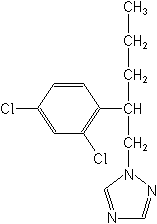Products >> Fungicides >> Penconazole
Penconazole
Penconazole 95%TC
Penconazole 10%EC
Fungicide
FRAC 3; DMI: triazole

Penconazole NOMENCLATURE
Common name penconazole (BSI, draft E-ISO, (m) draft F-ISO)
IUPAC name 1-(2,4-dichloro-b-propylphenethyl)-1H-1,2,4-triazole
Chemical Abstracts name 1-[2-(2,4-dichlorophenyl)pentyl]-1H-1,2,4-triazole
CAS RN [66246-88-6] EEC no. 266-275-6 Development codes CGA 71818
(Ciba-Geigy)
Penconazole APPLICATIONS
Biochemistry Sterol demethylation inhibitor; inhibits cell membrane
ergosterol biosynthesis, stopping development of the fungi. Mode
of action Systemic fungicide with protective and curative action.
Absorbed by the leaves, with translocation acropetally. Uses Control
of powdery mildew, pome fruit scab and other pathogenic Ascomycetes,
Basidiomycetes and Deuteromycetes on vines, pome fruit, stone fruit,
ornamentals, hops and vegetables, at 25-75 g/ha. Formulation types
EC; EW; WP. Selected tradenames: 'Topas' (Syngenta)
Penconazole OTHER TRADENAMES
'Donna' (Syngenta); 'Ofir' (Syngenta); 'Omnex' (Syngenta); 'Relax'
(Syngenta); 'Topaz' (Syngenta); 'Topaze' (Syngenta); 'Dallas' (Rocca)
mixtures: 'Preface' (+ dinocap) (Syngenta); 'Topas C' (+ captan)
(Syngenta) Discontinued names: 'Award' * (Ciba)
Penconazole ANALYSIS
Product analysis by glc. Residues determined by glc. Details available
from Syngenta.
Penconazole MAMMALIAN TOXICOLOGY
Reviews FAO/WHO 65, 67 (see part 2 of the Bibliography). Oral Acute
oral LD50 for rats 2125, mice 2444 mg/kg. Skin and eye Acute percutaneous
LD50 for rats >3000 mg/kg. Not a skin irritant; irritating to
eyes (rabbits). Not a skin sensitiser (guinea pigs). Inhalation
LC50 (4 h) >4000 mg/m3. NOEL (2 y) for rats 3.8, mice 0.71 mg/kg
b.w. daily; (1 y) for dogs 3.3 mg/kg b.w. daily. ADI (JMPR) 0.03
mg/kg b.w. [1992]. Other Not mutagenic, not teratogenic, not oncogenic.
Toxicity class WHO (a.i.) III (Table 5)
Penconazole ECOTOXICOLOGY
Birds Acute oral LD50 (8 d) for Japanese quail 2424, Pekin ducks
>3000, mallard ducks >1590 mg/kg. LC50 (8 d) for bobwhite
quail and mallard ducks >5620 ppm. Fish LC50 (96 h) for rainbow
trout 1.7-4.3, carp 3.8-4.6, bluegill sunfish 2.1-2.8 mg/l. Daphnia
IC50 (48 h) 7-11 mg/l. Algae IC50 (5 d) for Scenedesmus subspicatus
3.0 mg/l; EC50 (5 d) for Selenastrum capricornutum 0.83 mg/l. Bees
Non-toxic to bees; LD50 (oral and topical) >5 mg/bee. Worms LC50
(14 d) for earthworms >1000 mg/kg.
Penconazole ENVIRONMENTAL FATE
Animals After oral administration, penconazole is rapidly eliminated
practically to entirety with urine and faeces. Residues in tissues
were not significant and there was no evidence for accumulation.
Plants Metabolic pathways are hydroxylation of the propyl side-chain,
conjugation to glucosides or metabolism to triazolylalanine and
triazolylacetic acid. Soil/Environment DT50 in soil is 133-343 d,
depending on soil type. DT50 for photolysis is 4 d (natural sunlight).